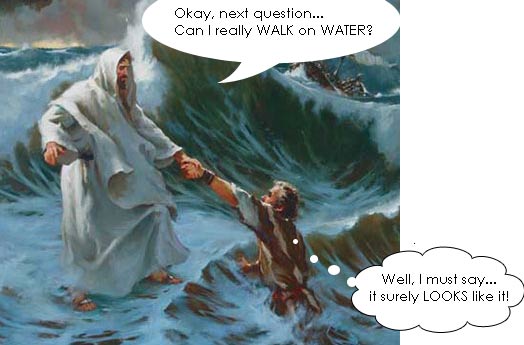Jesus walked on water
(Matthew 14:22-33, John 6:16-21, Mark 6:45-52)
![]()
![]()
Most serious bible researchers agree that Jesus never really walked on water. It has to do with a mistranslation of the original gospels of John and Mark.
Scholars agree that the most original, ‘uncorrupted’ version of the tale is in John 6:16-21. Here we read how the disciples go out in a boat on the Sea of Galilee (now Lake Kinneret) and suddenly are ‘terrified’ to see Jesus walking towards them... on the water.
Jesus calms them down. “Then they were willing to take him into the boat, and immediately the boat reached the shore where they were heading.”
But crucially, the original Greek text for the watery part (![]() ) can mean two different things: ‘on the sea’ or ‘on the seashore’. Now that obviously makes a big difference!
) can mean two different things: ‘on the sea’ or ‘on the seashore’. Now that obviously makes a big difference!
![]()
If you prefer the more logical translation ‘on the seashore’, the miracle suddenly vanishes. It becomes a quite dull and ordinary travel story:
"The disciples went out in their boat without Jesus, spotted him after a while on the seashore, were surprised to see him, and then took him aboard." You’ll have to admit: it's boring, but it makes more sense than water walking!
Already in 1929, the famous theologist and Irish archbishop John Henry Bernard noted:
We would have translated the Greek wording as ‘on the seashore’, and that would be it.
 |
|
![]()
In Mark, there is still no real miraculous water walking.
Here we read how Jesus takes a stroll on the water (or the shoreline) and even is ‘about to pass them by’ when the apostles spot him.
Mark elaborates on the fact that the apostles were terrified: “they thought he was a ghost”. Well, I would be pretty scared too, if I suddenly spotted a lonely, whitish figure on the shore in the middle of a stormy night.
But in Matthew, it all changes. Here, the story finally has become a full-blown miracle. Matthew copies Mark’s account of the event (in Matt 14:22-27), and takes it a lot further by adding five new verses (28-33).
Matthew makes it a tall story: Simon also leaves the boat and walks on the water, before he sinks and is saved by Jesus.
![]()
Matthew had good reason to make it a miracle. In those days, everyone linked water walking with godliness. In the Old Testament, the Lord does it all the time. For example, Job says of the Lord: “He alone […] treads on the waves of the sea.” (Job 9:8)
So all in all: no real walking on water. Matthew was only trying to say: “Look how God-like Jesus is! He does the water-walking routine! This guy really must be the messiah!”
Matthew took a somewhat sloppily written passage from Mark, and gave it a ‘miracle twist’ to place Jesus on equal footing with God.
![]()
![]()
![]() Some historians argue that Jesus might have been swimming. The Greek word for ‘walking’ was also used for ‘going’. It would have stunned the apostles to see Jesus ‘going over the water’, because in those days, even fishermen didn’t know how to swim. It might have been the first time they saw someone do it.
Some historians argue that Jesus might have been swimming. The Greek word for ‘walking’ was also used for ‘going’. It would have stunned the apostles to see Jesus ‘going over the water’, because in those days, even fishermen didn’t know how to swim. It might have been the first time they saw someone do it.
--
![]() The gospels also have a subtle difference when it comes to where the boat is when the apostles meet Jesus. In John, no position is given: John only mentions that the apostles had been rowing for a while – but they could have been in sight of the shore. Mark and Matthew take this a step further and write that the apostles were ‘in the middle of the sea’, setting the stage for the ‘miracle version’.
The gospels also have a subtle difference when it comes to where the boat is when the apostles meet Jesus. In John, no position is given: John only mentions that the apostles had been rowing for a while – but they could have been in sight of the shore. Mark and Matthew take this a step further and write that the apostles were ‘in the middle of the sea’, setting the stage for the ‘miracle version’.
--
![]() In April 2006, oceanographer Doron Nof of Florida State University pointed to another, less likely possibility. In the days of Jesus, the climate in the Middle East favored a very rare phenomenon: local freezing of lakes. According to Nof, Jesus could have actually walked on thin ice. That would have been a miracle in itself, since the phenomenon is supposed to be happen a few times in tenthousand years!
In April 2006, oceanographer Doron Nof of Florida State University pointed to another, less likely possibility. In the days of Jesus, the climate in the Middle East favored a very rare phenomenon: local freezing of lakes. According to Nof, Jesus could have actually walked on thin ice. That would have been a miracle in itself, since the phenomenon is supposed to be happen a few times in tenthousand years!
![]()
Patrick J. Madde: “Jesus’ walking on the sea” (PhD thesis, Catholic University of America, 1997)